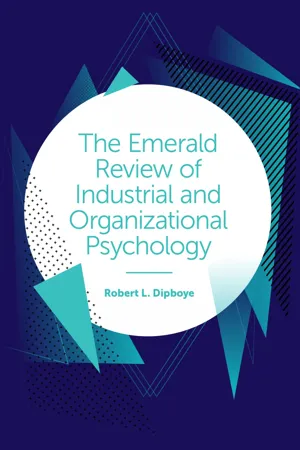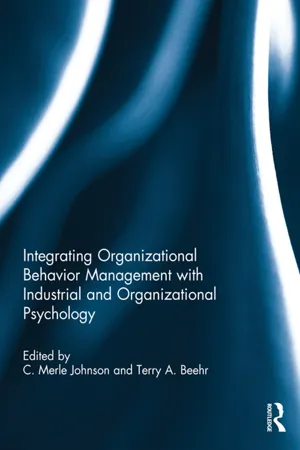Business
Job Satisfaction Outcomes
Job satisfaction outcomes refer to the positive or negative results of an individual's feelings and attitudes toward their job. These outcomes can include increased productivity, higher employee retention, improved morale, and better overall job performance. Conversely, low job satisfaction can lead to absenteeism, turnover, and decreased productivity.
Written by Perlego with AI-assistance
Related key terms
Related key terms
1 of 4
Related key terms
1 of 3
11 Key excerpts on "Job Satisfaction Outcomes"
- Robert L. Dipboye(Author)
- 2018(Publication Date)
- Emerald Publishing Limited(Publisher)
The Affective Event Theory states that, over time, recurring moods and emotions at work lead to more permanent work-related attitudes (Weiss & Cropanzano, 1996). Specifically, employees form attitudes toward facets of their work (e.g., coworkers, supervisor, work itself) around the strong and recurring affective reactions to work events. In addition to the average of day-to-day affective responses to work events, the variability around this average also influences job satisfaction. Xu, Martinez, Van Hoof, Eljuri, and Arciniegas (2016) found that employees who were more variabile in their emotions at work had lower job satisfaction. They further found that emotional exhaustion mediated the effect of variability on job satisfaction. Apparently, swings in emotion required more cognitive resources to manage the emotion, exhausting the employee and lowering job satisfaction.Outcomes of Job Satisfaction/Dissatisfaction
A century of research shows that higher job satisfaction is associated with a variety of positive outcomes. Table 4.1 contains the results of several meta-analyses. To summarize, a satisfied employee- is less frequently absent from work;
- is less likely to leave the job (turnover);
- is less frequently late to work;
- tends to show more organizational citizenship (behaviors that help out coworkers and others but are not required as part of the job);
- is less likely to show counterproductive behavior such as fighting, theft, and the like;
- receives more positive supervisory performance ratings;
- performs more effectively on objective measures;
- rates his or her own performance more positively;
- is more committed to the organization;
- evaluates his or her life satisfaction and happiness more positively;
- reports less role stress (conflict and ambiguity);
- is mentally healthier;
- is physically healthier.
This is an impressive list of benefits that appears to support the Human Relations assertion that management should do whatever it can to increase employee satisfaction with the job. However, there are complications. First, we cannot infer causality from these correlational results. Job satisfaction could be the outcome of the other variable or both could be caused by a third variable. A second complication is that correlates of job satisfaction (e.g., stress, mental health) contain some items similar to or identical with items in the job satisfaction measures. Also, the use of self-report in both the satisfaction measures and the measures of the other variables raises the possibility of common method bias. Both item overlap and common method bias would have the effect of inflating the correlations. A final complication is variability across situations in the size and the direction of correlations. There are situations in which satisfaction is positively related to outcomes and other situations in which there is no relation or even a negative relation. These variations may reflect the moderating influence of third variables on the satisfaction–outcome relation. Perhaps the most important question is whether a happy worker is also a high performing worker. Consequently, I will focus on the correlation with performance in elaborating on these complications.- Colin P. Silverthorne(Author)
- 2005(Publication Date)
- NYU Press(Publisher)
10Job Satisfaction and Organizational Commitment Motivation and performance are influenced by the emotions we experience both at work and in our personal lives. How our attitudes and emotions affect our behavior is explored in this chapter.Job Satisfaction
The very extensive literature concerning job satisfaction indicates that, across a variety of work settings, job satisfaction is an important workplace construct that is of concern for effective management. Job satisfaction is defined as “a pleasurable or positive emotional state resulting from the appraisal of one’s job” (including various facets of that job). Job satisfaction can be broken down into three general areas: the values that an individual has or wants, the perception of how the organization meets these values, and their relative importance to the individual (Locke, 1976). Job satisfaction has been linked to positive workplace outcomes such as increased organizational commitment, with workers having high levels of job satisfaction being more likely to be committed to the organization (Brown and Peterson, 1994). Furthermore, individuals with higher levels of job satisfaction are less likely to seek out a different job (Sager, 1994) or to leave the organization (Boles, Johnson, and Hair, 1997). Employee job satisfaction is also a function of intrinsic and extrinsic rewards offered by a job (Tuch and Martin, 1991), status associated with job level (Cox and Nkomo, 1991), and work values (Drummond and Stoddard, 1991). Furthermore, task, status, monetary reward, and social relationships (or a team dimension) are four essential aspects of job satisfaction (Neil and Snizek, 1987) and are also important dimensions of work values (Shuka, Sarna, and Nigam, 1989). They are the basis of the reward thesis, which explains higher job satisfaction by the intrinsic and extrinsic rewards obtained from a promotion (Wright, Bengtsson, and Frankenberg, 1994). As mentioned earlier, turnover is a major issue for many organizations and is very important to control because of the costs associated with hiring and training new personnel, as well as the costs associated with not having that individual contributing his or her work efforts toward organizational goals. Creating and maintaining a high level of job satisfaction is one of the most important attitudinal issues faced by managers in the workplace.- eBook - ePub
Organizational Psychology
A Scientist-Practitioner Approach
- Steve M. Jex, Thomas W. Britt(Authors)
- 2014(Publication Date)
- Wiley(Publisher)
Finally, a measure of job satisfaction included in a longer assessment of organizational perceptions and attitudes is the job satisfaction subscale of the Michigan Organizational Assessment Questionnaire (Cammann, Fichman, Jenkins, & Klesh, 1983). This is an overall measure of job satisfaction that includes only three items: (1) All in all, I am satisfied with my job, (2) In general, I don't like my job, and (3) In general, I like working here. Bowling and Hammond (2008) conducted a meta-analysis of 79 relationships between the job satisfaction measure and theoretically related variables, and found that the measure demonstrated appropriate correlations with related constructs such as work stressors and organizational perceptions (e.g., perceptions of justice in the workplace and doing significant work).In conclusion, a number of valid measures exist to measure overall job satisfaction and satisfaction with different aspects of one's job. The normative information on many of these scales is especially useful for organizational psychologists who want to be able to compare their employees to employees from similar occupations and organizations. Now that we have addressed the prediction and measurement of job satisfaction, we address the important question of outcomes predicted by job satisfaction.Predictors of Job Satisfaction
A substantial portion of the research conducted on job satisfaction over the years has been devoted to explaining what exactly determines employees' levels of job satisfaction. Understanding the development of job satisfaction is certainly of theoretical importance to organizational psychologists. It is also of practical interest to organizations as they attempt to influence employees' levels of job satisfaction and, ultimately, other important outcomes.There are three general approaches to explaining the development of job satisfaction: (1) job characteristics, (2) social information processing, and (3) dispositional - Steven G. Rogelberg(Author)
- 2006(Publication Date)
- SAGE Publications, Inc(Publisher)
Job satisfaction is often seen as an important outcome in its own right. From a social and humanitarian perspective, there is obvious value in having a society in which people have positive views about their work and feel they are treated with dignity and respect. After all, individuals spend up to one third of their waking hours in the workplace. In addition, however, job satisfaction can affect important personal and organizational outcomes. Some of the most well-established ones are discussed next.Life Satisfaction and Health
For a small number of individuals, job and life experiences are segmented and have little effect on each other. For an even smaller group, the compensation model applies, meaning that individuals seek to compensate for a dissatisfying job by looking for fulfillment outside of work. For most individuals (around 70%), however, job experiences spill over and affect their lives more broadly. This spillover model is supported by evidence that job satisfaction has a moderately strong positive correlation with one’s overall life satisfaction. It seems that how one feels and/or thinks about one’s job tends to affect how one feels and/or thinks more broadly. The reverse is also true: One’s broader life satisfaction can affect job satisfaction.In terms of health, there are clear links between job satisfaction and mental health, such as depression and burnout. Burnout is a distressed emotional state experienced on the job, such as feeling emotionally exhausted and feeling a reduced sense of personal accomplishment. Job dissatisfaction has also been associated with physical symptoms such as headaches, although the methodological limitations of most studies in this area (e.g., an overreliance on self-reported assessments of health) preclude any conclusion about causality at this stage.Job Performance and Other Important Organizational Behaviors
It is intuitively appealing to believe that the happy worker is also a productive one. However, in the mid-1980s, a very influential meta-analysis of the literature suggested a relatively low correlation (.17) between job satisfaction and performance. At this point, the effect of job satisfaction on performance appeared trivial.- Steven G. Rogelberg(Author)
- 2016(Publication Date)
- SAGE Publications, Inc(Publisher)
How much we like our jobs—our job satisfaction—is a critical concept in the study of work. Job satisfaction is likely to result in a number of positive benefits, both for individuals (their well-being, mental health, and life satisfaction) and for organizations (better performance, more citizenship, less counterproductive behavior, and less withdrawal). Importantly, job satisfaction can be changed. Even though our job satisfaction is in part a product of who we are, regardless of our job or work situation, our job satisfaction is also significantly affected by the work situation. In many instances, the work environment can and should be changed, such as by reducing excess workload, increasing levels of job autonomy, or introducing practices to reduce home–work conflict. Such change initiatives are especially likely to be successful in raising job satisfaction if one takes into account individual values and personality in this process.Sharon K. ParkerSee also Attitudes and Beliefs ; Job Design ; Job Performance Models ; Withdrawal Behaviors, Absenteeism ; Withdrawal Behaviors, Lateness ; Withdrawal Behaviors, TurnoverFurther Readings
Braun, S., Peus, C., Weisweiler, S., & Frey, D. (2013). Transformational leadership, job satisfaction, and team performance: A multilevel mediation model of trust. Leadership Quarterly, 24(1), 270–283.Chen, G., Ployhart, R. E., Thomas, H. C., Anderson, N., & Bliese, P. D. (2011). The power of momentum: A new model of dynamic relationships between job satisfaction change and turnover intentions. Academy of Management Journal, 54- eBook - ePub
- Maria C.W. Peeters, Jan de Jonge, Toon Taris, Maria C.W. Peeters, Jan de Jonge, Toon W. Taris(Authors)
- 2013(Publication Date)
- Wiley-Blackwell(Publisher)
Because job satisfaction and job performance are both complex variables, it is important to provide clear definitions of each and to describe their various dimensions. The satisfaction and performance dimensions described in the following sub-sections will guide much of the discussion of the current chapter.Job satisfaction
Job satisfaction is an attitude that represents the extent to which a person likes or dislikes his or her job (Brief, 1998). Like other attitudes, job satisfaction includes both an affective and a cognitive component (Schleicher, Watt, & Greguras, 2004). The affective component of job satisfaction reflects the emotions or feelings one has in response to one’s job (e.g. feelings of excitement, contentment or joy), whereas the cognitive component refers to one’s thoughts or beliefs about the job (e.g. beliefs that one’s job offers autonomy, challenge or variety). As discussed below, the global satisfaction approach and the facet satisfaction approach represent the two primary ways of conceptualizing job satisfaction.Global job satisfaction
Global job satisfaction focuses on workers’ overall attitude toward their jobs and is illustrated by the following self-report items from the Michigan Organizational Assessment Questionnaire (Cammann, Fichman, Jenkins, & Klesh, 1979):‘All in all I am satisfied with my job.’ ‘In general, I like working here.’ ‘In general, I don’t like my job.’ (Note that this third item is reverse-scored.)Facet job satisfaction
Facet job satisfaction, on the other hand, focuses on workers’ attitudes toward specific aspects of their job. For example, the Job Descriptive Index (JDI; Smith, Kendall, & Hulin, 1969), the most commonly used measure of facet satisfaction, assesses satisfaction with five specific aspects of work: (i) work tasks, (ii) supervision, (iii) co-workers, (iv) pay and (v) promotional opportunities. The JDI, like other facet satisfaction measures, yields separate satisfaction scores for each job satisfaction sub-dimension. Thus, the facet approach recognizes that a given worker can be satisfied with some aspects of work, but dissatisfied with others. The following example items from Beehr et al. (2006) are representative of the type of content typically assessed by facet satisfaction measures: - eBook - ePub
Managing Human Resources
Human Resource Management in Transition
- Stephen Bach, Martin Edwards, Stephen Bach, Martin Edwards(Authors)
- 2012(Publication Date)
- Wiley(Publisher)
Researchers have questioned the validity of many of these claims (Schaufeli and Bakker 2010). There is no doubt, however, that the consequences of engagement are a central concern also in the academic literature where work engagement is, by and large, thought to have a positive effect on a range of outcomes important to both individuals and organisations. These include, for example, various aspects of task and contextual performance, turnover, absence and employee health outcomes. A number of researchers also treat key employee attitudes, such as job satisfaction and organisational commitment, as outcomes of engagement (Albrecht 2010b; Cole et al. 2011). In line with our earlier discussion, however, these job attitudes are more appropriately conceptualised as correlates rather than as outcomes of engagement and will not, therefore, be examined again in this section. Here I focus primarily on key performance, turnover and health-related outcomes that have been examined in a range of individual studies and summarised in Christian et al.’s (2011) and Halbesleben’s (2010) recent meta-analyses. Some of the potential negative effects of engagement, or what is sometimes referred to as the ‘dark side’ of engagement (Bakker and Leiter 2010b, Bakker et al. 2011a), will also be briefly considered. Job performance outcomes Research on the relationship between work engagement and job performance has focused on both task and contextual performance. Task or in-role performance refers to how well an individual performs the duties required by the job, while contextual or extra-role performance refers to discretionary behaviours on the part of the individual that are not formally required as part of the job, but which contribute to the effective functioning of the organisation (Borman and Motowidlo 1993) - eBook - ePub
- C. Merle Johnson, Terry Beehr, C. Merle Johnson, Terry A. Beehr(Authors)
- 2013(Publication Date)
- Routledge(Publisher)
C. Smith (1967) defined JS “as an affective response of the worker to his job... [and is]... similar in meaning to pleasure” (p. 343; emphasis added). She went on to lament “the fact that there is no necessary connection between productivity and satisfaction” (p. 343). Schleicher, Hansen, and Fox (2010) recognize another two definitions of satisfaction involving affect and emotion: first, Locke’s (1969) conception of it as a “state resulting from an employee’s perception that his or her job allowed for the fulfillment of his or her values,” and Cranny, Smith, and Stone (1992) characterized JS as “an emotional state resulting from an employee’s comparison of actual and desired job outcomes” (p. 148). The second approach identified by Schleicher et al. (2010; citing Rosenberg & Hoveland, 1960) characterizes JS “as an attitude, rather than (and distinct from) an emotional state.” Job attitudes are not behavior, rather they are “personal construct [s] [P c s] [emphasis added] that can be used to describe people [emphasis added]” (Zedeck, 2010, p. xxii). And these constructs, manifest as scores on JS surveys, play the role of P c in IOP’s grand theory. Often, performance behavior, B c, is measured by supervisors’ ratings (Schleicher et al., 2010, p. 153, Table 4.1). Note behavior may itself be a construct. Organizational citizenship behavior (OCB) is a construct, B c, typically assessed via paper and pencil responses about behavior descriptions on rating scales (Organ, Podsakoff, & MacKenzie, 2006), rather than tangible behavior per se or tangible consequences of behavior in the traditions of OBM (Gilbert, 1978) - eBook - ePub
- Craig C. Pinder(Author)
- 2014(Publication Date)
- Psychology Press(Publisher)
Fields (2002) lists many scales of proven validity. Indeed, even some of the scales that brag the best early psychometric properties continue to undergo scrutiny (e.g., Kinicki, McKee-Ryan, Schriesheim, & Carson, 2002). There is no longer any excuse for researchers to construct home-made measures of job satisfaction.Conclusions on Job Satisfaction and a Glance Ahead
In the foregoing sections of this chapter (as well as in parts of Chapter 4 ), we have seen that job satisfaction (and dissatisfaction) are complex motivation-related phenomena, containing both attitudinal and affective elements. We have seen that both are influenced by a range of individual and organizational variables and they, in turn, can have significant effects on a range of other individual as well as organizational variables. The history of the study of job attitudes is as old as the history of the organizational sciences and history has seen a cyclical pattern of attention being paid to people’s feelings about their jobs. The frustrated attempts through the 1980s to find the widely anticipated causal connections between job attitudes and individual performance portended a decline in scientific interest, even though practitioners seemed to believe that “a satisfied employee is a productive employee.” The connections between job attitudes and nonperformance variables, especially withdrawal behaviors, never lost their value in the eyes of either researchers or practitioners. Then, with the introduction of more appropriate conceptualizations of job attitudes (as within-individual phenomena) in the 1990s, research on job attitudes and all of its antecedents and consequences enjoyed a renaissance and the topic is now again “popular” in the academic literature.Aside from the historical significance of the phenomena, the more important issue, for this author, is the tremendous significance they have as experienced by working people. Those who have experienced the joys of working know what this means, as do those who have suffered the frustrations of job and career dissatisfaction: They really hurt, and they deliver significant impacts on our daily lives, both while we are actually at work as well as when we are not. - eBook - ePub
Decoding the Workplace
50 Keys to Understanding People in Organizations
- John Ballard Ph.D.(Author)
- 2015(Publication Date)
- Praeger(Publisher)
4 Hundreds of studies are conducted every year. The findings about job satisfaction and performance are counterintuitive. The happy worker is not necessarily a more productive worker. In statistical terms there is only a small correlation between job satisfaction and individual performance.Why so many studies? To try to determine when and where job satisfaction might be related to performance. To study which aspects of job satisfaction might be related to performance. To study the effects of job dissatisfaction. To look at job satisfaction and job dissatisfaction from every angle and possibility. Does this mean that companies should not be concerned about whether their employees like their jobs? Of course they should be concerned. It affects an organization’s bottom line and other things, as we shall see.Key: People who are happier in their jobs are not necessarily more productive, but they are more likely to show up for work and not leave the organization.Employee turnover is costly. Regardless of the level of the employee in the organization, there are costs to recruit and train. These costs increase depending upon the employee’s level within the company. An unhappy worker is more likely to leave an organization or not show up for work. Although the relationship of job satisfaction to performance is not as strong as most would expect, the relationships between job dissatisfaction and turnover and absenteeism are very strong.Job satisfaction is an attitude. Understanding attitudes is important to understanding yourself and others. An attitude is how you feel about something, some belief, either positive or negative. Beliefs are cognitive, things we have learned. I see a little animal that says “meow” and has whiskers. It’s a cat. That’s the belief level. But “I love cats” is an attitude. Conversely, I might dislike cats—which still is an attitude. We all have attitudes; they develop across our life experiences. Some are rooted deep in one’s childhood. Others were formed last week, or even yesterday. And they all can change. - eBook - ePub
Diversity in Unity: Perspectives from Psychology and Behavioral Sciences
Proceedings of the Asia-Pacific Research in Social Sciences and Humanities, Depok, Indonesia, November 7-9, 2016: Topics in Psychology and Behavioral Sciences
- Amarina Ashar Ariyanto, Hamdi Muluk, Peter Newcombe, Fred Piercy, Elizabeth Kristi Poerwandari, Sri Hartati Suradijono, Amarina Ashar Ariyanto, Hamdi Muluk, Peter Newcombe, Fred P Piercy, Elizabeth Kristi Poerwandari, Sri Hartati R. Suradijono(Authors)
- 2017(Publication Date)
- Routledge(Publisher)
According to Mintzberg (1993) universities are educational organisations with a structure of professional bureaucracy. In such structures, many types of job are rather stable and predictable. However, due to the complexity of the dynamics of such jobs, there is a need for supervision by the operators of those jobs. In this context, operators refers to the people who hold the knowledge and ability to conduct the function of the job. In this case, these people are lecturers.Organisational commitment is a psychological state that (a) characterises the employee’s relationship with the organisation, and (b) has implications for the decision to continue membership in the organisation (Meyer & Allen, 1997). As we have already indicated, there are three components of organisational commitment: affective (individual emotional ties, identification, and involvement within an organisation), normative (the obligation to stay in an organisation), and continuance (the individual perception of cost of leaving an organisation).In this study, psychological climate is the perception by lecturers of their job context that influences their psychological processes, leading either to engagement or disengagement from that job (Kahn, 1990). In this study, we refer to the development of Kahn’s theory by Brown and Leigh (1996), which divides each of the psychological safety and meaningfulness aspects described above into three dimensions. An individual will feel that his/her job is meaningful if the job is challenging, yields contribution, and also results in recognition.According to Spector (1997), job satisfaction is simply how people feel about their jobs and different aspects of their jobs. We conclude that job satisfaction is an attitude by which an individual expresses their feelings toward a job in general, or even toward specific aspects of each job. Spector (1997) divided job satisfaction into nine aspects, namely, pay, promotion, supervision, nature of work, communication, fringe benefits, rewards, operating procedures, and co-workers.2 METHODSThis study employed a quantitative approach. Respondents were lecturers from public and private universities selected on the basis of two main criteria: those who had been employed for more than two years, and who were either civil servants (PNS) or non-civil servants (non-PNS). The selected sampling technique was a non-probability sampling, that is, sampling based on availability. We employed three main questionnaires as our measurement tools. The questionnaires concerned organisational commitment, as designed by Seniati and Yulianto (2010) with 21 items (α = 0.88), psychological climate, as designed by Brown and Leigh (1996) with 21 items (α = 0.89), and job satisfaction, as designed by Seniati and Yulianto (2010) with 21 items (α = 0.91). These questionnaires use Likert-type scales of 1 (Strongly disagree) to 4 (Strongly agree). We employed a simple mediator technique to answer the research question, which was whether job satisfaction functions as a mediator in the relationship between psychological climate and organisational commitment. The data was processed and analysed statistically using IBM SPSS software with the PROCESS add-on macro by Hayes (2013).
Index pages curate the most relevant extracts from our library of academic textbooks. They’ve been created using an in-house natural language model (NLM), each adding context and meaning to key research topics.
Explore more topic indexes
Explore more topic indexes
1 of 6
Explore more topic indexes
1 of 4










